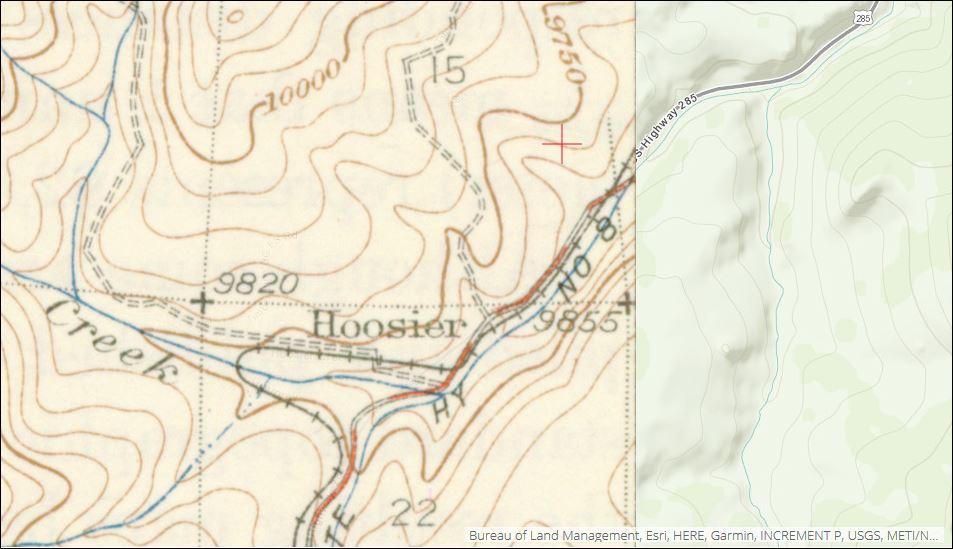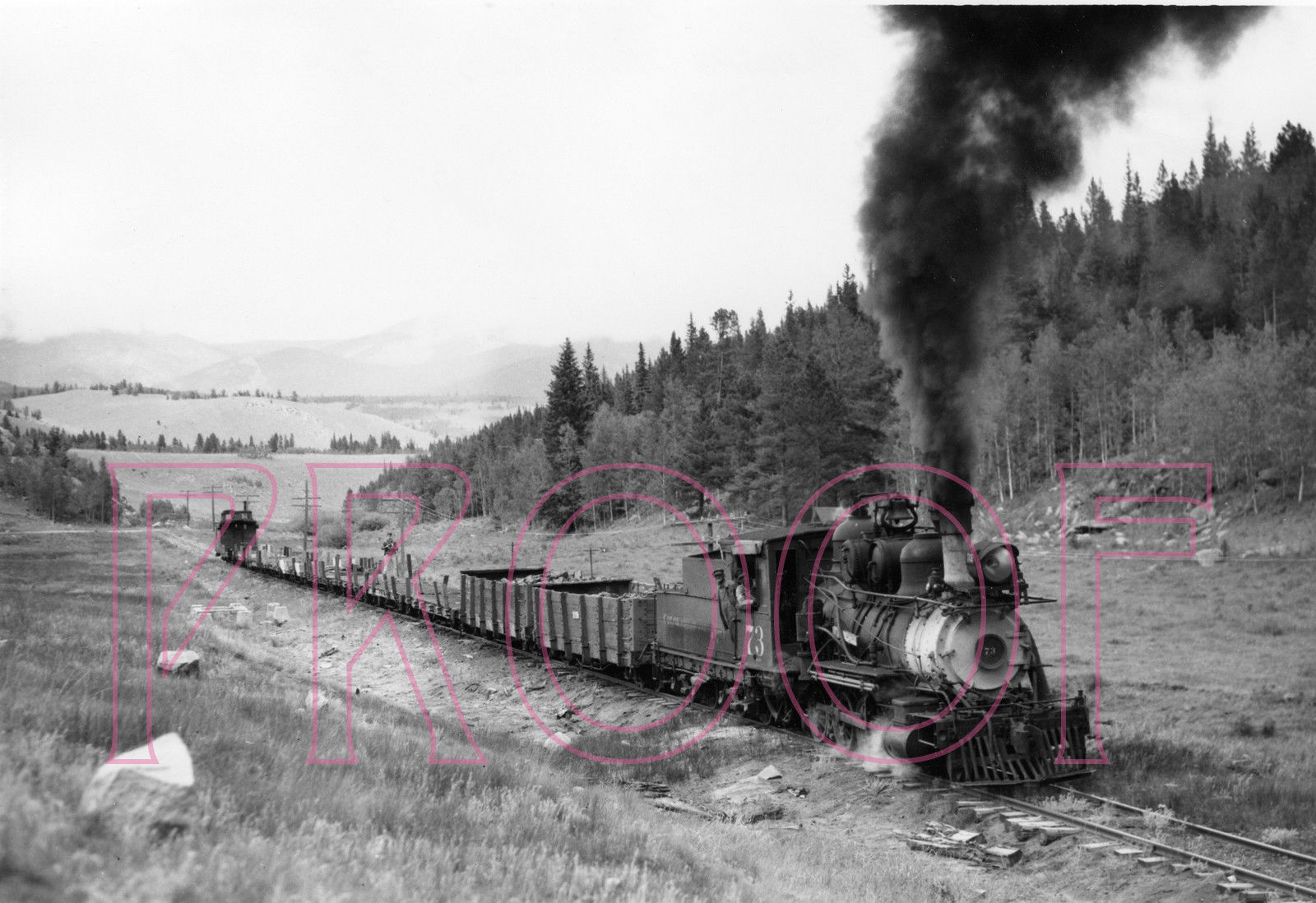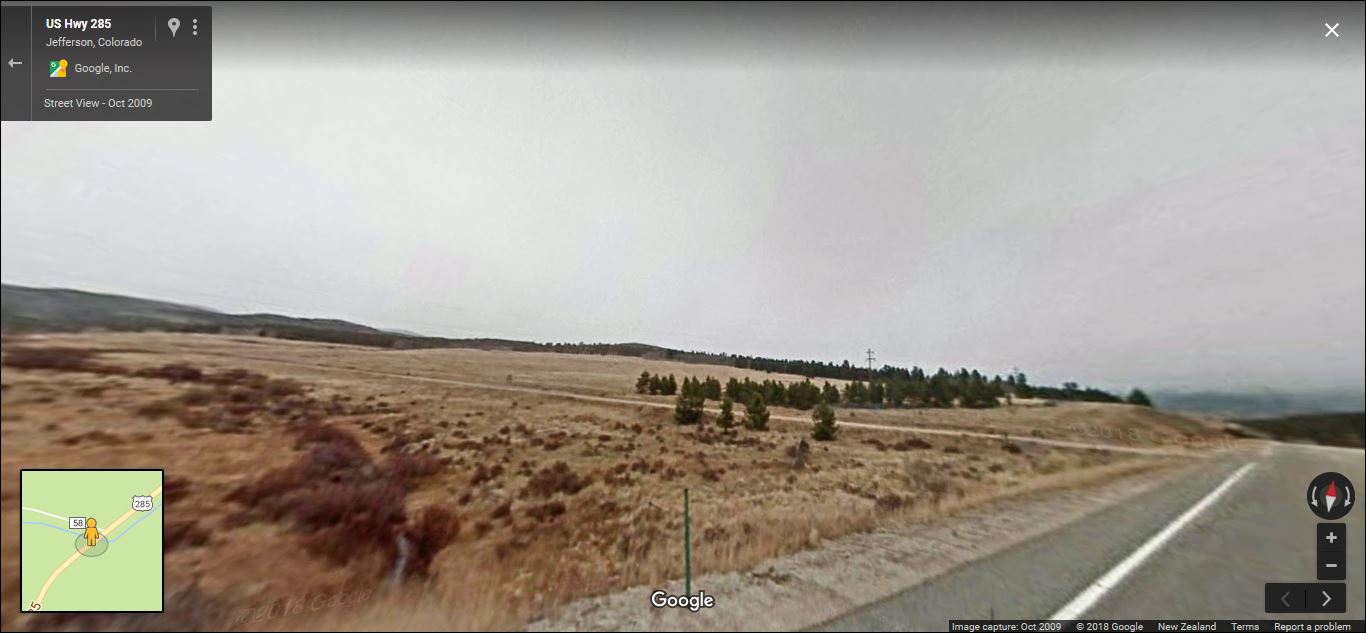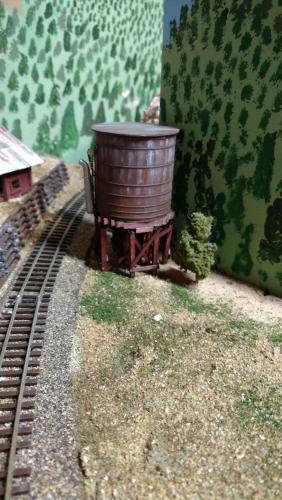C&S Water Tank at Blackhawk and the "Three Bent Water Tanks".
1234

















1234
Hoosier -- Ghost of C&S "Three Bent Tank"?
|
I wanted to see if this played out in the original thread http://c-sng-discussion-forum.41377.n7.nabble.com/Coal-and-Water-on-the-South-Park-tp1381p2272.html and sow the seeds of (yet
 ) another of my theories, but no-one answered and I went off elsewhere. ) another of my theories, but no-one answered and I went off elsewhere.  What I believe is this picture was taken at the Hoosier Tank location and just not recognised as a separate locality by the Authors of the three books I know this to have been published in: C&Sng, Mineral Belt V-1 and CRRA #12. The key is the Cross-Bucks in the rear, quite clearly shown and that the photographer known to be chasing the train would be stopped on the Highway, which pre re-alignment, did cross the C&S Mainline twice at Hoosier but only once at Kenosha, and that was South of, at the Wye. The angle of the Highway Crossing is also progressing from the left looking East, which it would not be if this was the Western most Crossing where the Railroad turned up Hoosier Cr. and the Highway stayed on another drainage(not Kenosha Cr.) There is also a somewhat steeper ridgeline to the right that does not happen at the Summit. If I was to guesstimate the location, it looks to be above the "9" of the 9985 foot elevation notation on the Topograpical Map presented below. Mac Poor states in D,SP&P.... 47,500 gal. wood water tank. Records tell us the water supply here was not only bad but that it was also limited.  USGS http://historicalmaps.arcgis.com/usgs/  USGS http://historicalmaps.arcgis.com/usgs/  GoogleMaps.
UpSideDownC
in New Zealand |
Re: Hoosier -- Ghost of C&S "Three Bent Tank"?
|
Well, Chris, I think your theory is correct. Makes sense, too -- if you can't find records of a water tank at Kenosha, find a nearby location that was known to have a water tank. Hoosier fits the bill.
The 1918 valuation map set shows the Hoosier water tank to be gone by 1918:  The two highway crossings are shown, the one you reference is to the right. No water tank depicted (they are clearly labeled as such at other locations) There is a hint that your location for Hoosier tank is correct (orange arrow): There is a notation for a sign "W". I doubt this is a whistle board, so far from each of the crossings, with no signs on either side of the crossings. Hoosier siding was located around the curve to the west. There is no depiction of a water tank on the next map sheet to the west, either. So, if this is the remains of Hoosier tank in the photos, some of the piers must have been removed or are hiding in the weeds. the big 47,500 gal tanks in the standard plans were supported by 4 bents.  High resolution scan available in "Files" section on main page. Amazing the things that we figure out on Roper's forum. 
Jim Courtney
Poulsbo, WA |
Re: Hoosier -- Ghost of C&S "Three Bent Tank"?
|
Further study suggests that the "Hoosier" tank was gone before 1906 -- the employee's timetable from June, 1906, in the back of CRA-12 shows water tanks at Webster and Jefferson, but not Hoosier. If the Hoosier tank is a bit distant from Hoosier siding, as Chris has suggested, I suppose it is possible that water was not listed at Hoosier siding per se.
But the timetable does mention the tank at Buffalo (Riverview) as distinctly separate from Buffalo station; there is no mention of a similar tank near but distinctly separate from Hoosier. One other thought, Chris: Is it possible that the location of the photo is further west, along the tangent leading to Hoosier siding? That would mean the distant road crossing in the background is the western most crossing on the valuation map. Hoosier Creek would be running parallel to the track to the right in the photo. I suggest this as there is another "W" sign noted upgrade from Hoosier siding, west of where the track loops back after crossing Hoosier Creek on a box culvert, located above the "E" of STATE HWY on your map. Such signs were to remind the engineer, from either direction, that he was approaching a water tank. They would be placed some distance on either side of the water tank, not at the water tank itself. If so, that would suggest that the piers in the photo are somewhere along the tangent near Hoosier siding, just a little further west than your suggested location. Hoosier siding itself may have been removed by 1937, I guess. Anyways, just another thought.
Jim Courtney
Poulsbo, WA |
Re: Hoosier -- Ghost of C&S "Tank"
|
Jim,
I think you are spot on about the 2 piers being hidden in the weeds or missing, although I can't seen them there.  As to the possibility of the Tank site being adjacent to the Siding, I have considered that and even reconsidered it last night but the topography is flatter there if the photo had be taken up the draw of Hoosier Cr. near the turnback curve. That road served the former Stage Station of Hoosier, would have been marginally improved not showing the proper grade like that seen in the #73 picture and I wonder would if it even have had Crossbucks since it would be carrying little traffic?  Google view The current sideroad seen in the Google view is not that of the roadway alignment of the C&S period, see the Topo Map in my previous post. You mentioned a W Sign; in my book that has always meant Whistle, usually at any location requiring an audible warning such as tunnels and as for roadway crossings, which usually were an X and an S for Station. I never seen nor heard of a Water tank having a signpost specifically for a Waterstop. To my thinking that would be in the Local knowledge category. Rick Steele, what do you think?
UpSideDownC
in New Zealand |
Re: Hoosier -- Ghost of C&S "Tank"
|
The missing piers may not be the only things off in the weeds, Chris. Perhaps this discussion is headed that way, too!
 For what it is worth, the following 1918 Valuation Map sheet overlaps the sheet that I posted above, at Hoosier:  West of Hoosier siding the track makes a loop and crosses Hoosier Creek. Another "W" sign is noted a bit further west. The W sign to the east of Hoosier is north of the track, so visible to the engineer of a west bound (upgrade) locomotive. The W sign to the west of Hoosier is south of the track, visible to the engineer of an east bound (downgrade) locomotive. If we assume that the "W" signs indicate a water tank ahead (they show up on both sides of many water tanks on the valuation maps), then we might guess the approximate location of Hoosier tank, if it were equidistant from both signs. That would put it north (track direction west) of Hoosier siding, as marked on the map above. So, Chris, it may be that the road crossing in the photo is not that of the "Highway" grade, but rather the old stage road that crossed the tracks in Hoosier(the double hatched road on your first map). In your re-posting of the photo, notice a pair of cars parked in the distance (inside the loop of the purple "P" of "PROOF". Perhaps out train chasing photographers parked down near the siding, and hiked up the grade to get a better photograph. If so, he or they are standing almost exactly at Mile Post 74, looking south-southwest. Is it possible that one of the locals, like Como Depot or Jeff Ramsey, could make a field trip up to the Hoosier site? See if any lost concrete footing piers are still around? 
Jim Courtney
Poulsbo, WA |
Re: Hoosier -- Ghost of C&S "Tank"
|
Jim,
some musings, since I don't have the Valuation maps. The Colorado Central Rail Road book by Abbott, McCoy, McLeod does have parts of Clear Creek in it, from what I can find there they used the "S" sign for Stations, that I find interesting. The only Tank location that was legible to me, Elk Creek, didn't have a sign specific to the Tank, but did have the trackside warning signs and the actual, Station Sign. They didn't show the Forks Creek part  either. Have you checked for the "W" vs "S" at other locations, or was there a difference between the UP,D&G vs D,L&G lines? My steam era Union Pacific Roadway Signs book shows "S" for Station. either. Have you checked for the "W" vs "S" at other locations, or was there a difference between the UP,D&G vs D,L&G lines? My steam era Union Pacific Roadway Signs book shows "S" for Station.
My CRRA #12 didn't come with a ETT in the back such as you mention but I do have a loose reprint of C&S South Park Division № 1 ETT. June 5, 1922. From that I gleen that Hoosier had a 9 car cap siding, down somewhat from Mac Poor's DSP&P listing of 590 ft.  I don't see any cars parked there, just rocks as the line emerges from the cut, and I also don't see any evidence of any formation raised for the Siding either, if this is at the location of Hoosier as you suggest. Given the clarity and height of those Crossbucks visible for scale. One thing that struck me over the years of looking at train photographs, was the fact they appeared to be in the middle of no-where and in reality after visiting the US and finding such vantage points was the fact that the roadway was usually right behind the photographer most of the time.  I do like your idea to call upon a "local" to take comparison shots since the Googlecar was through there on an awful day. Any takers on their way to Como?
UpSideDownC
in New Zealand |
Re: C&S Water Tank at Blackhawk, December 11, 1913.
|
In reply to this post by Jim Courtney
Interesting Jim,
The tank listed as Structure #5 in the valuation Sec. 13A 10-11-18: W. Tank 16' ht x 16' d on tower P(ainted) Construction similar to 18-1-1-2 (probably from Val. Sec. 18) flat roof 1x3 batts in 3x12 12" proj. tub.-3"wood staves typ grill 4 x 24 @ 18" cc. 3 -12 x 14 caps, 8 posts. 9-6 6 reg 8-3 x 12 x 16' on 3-12 x 14 sills fdn. 20' x 16'x of SH 8 x 16 flat on gr. 1 frost box 5' x 6'x 12' ht. no paint 3' pit of 3" wood curb. 1 riser 18' of 4" w.i. pipe two flanges 1 riser 18' of 1" galv. pipe - I U 1 14' gabel 1 30' wood ladder 1 14' wood 1 8" FM trk soput - ctr wts. City water supply Structure # 6 Pump Ho. (out of use. Water from city) Structure #7 Well. (well out of use.) |
|
First time poster here (occasional poster on the NGDF), fan of the South Park for the last 60 years. I'll give my 2 cents worth of opinion to the photo of #73 hauling the empty flat cars for the scrap train and the discussion of the Hoosiers tank in this thread. I believe the footings in the stated picture are the footings for the Hoosier Tank. It took me a long time to find the location of this picture as it looks today. It is not near the top of Kenosha Pass, rather it is the stated distance (or close to it) as listed in Mac Poor's DSP&P book station list via the railroad from Kenosha. The rock cut behind the caboose is one (I believe) where Richard Jackson took a picture of C&S #9 pulling a passenger train in the mid 30's a year or two or so before abandonment. That picture is in the Pictorial Supplement. It makes sense that if he was chasing trains it would have been a good location to get a picture. He could park on the state road shoulder and not walk far to get a picture with decent scenery and no roads in it. Today US285 has obliterated the rock cut the railroad went through, cutting it back to make room for it's pavement. It then occupies the railroad grade through this location several feet above the the original grade, burying the Hoosier tank footings in the process. The old state road still shows scars on the west side of the present highway. What really nails the location is the hills and mountains in the background, they look the same as they did 80 plus years ago when the picture of #73 was taken. Also the topo maps posted in this thread further cemented my opinion of this location, I'd never seen then before. I took a picture of this location in the same direction and location as the original, but I'll be ----- if I can find that picture now. Unfortunately I don't have any of my reference materials with me since I'm at work in New Mexico and live in Aurora, CO otherwise I could have given page numbers, exact dates, etc.
|
|
I have to eat my words a little now that I have my reference materials. The picture I took is further west than I remembered (8-10 years ago). I've included the picture in this post. Also it was C&S #8 not #9 on the passenger train in 1931 not a year or two before abandonment.
 I think the original picture of #73 was taken about where US285 passes the rock face (closer to me) in the picture I took, and appears to be about the location of the second crossing of the old state road looking at the topo map.  |
Re: C&S Water Tank at Blackhawk, December 11, 1913.
|
One of my favorite South Park images.
|
Re: Hoosier -- Ghost of C&S "Tank"
|
Administrator
|
In reply to this post by Jim Courtney
Jim, are you referring to "S" and "W" which appear on a map or timetable?
To my knowledge, actual signs on the right of way for "W" is a signal to whistle, which could be a road crossing or station approach. "S", is a symbol indicating a spring switch. I do agree that "W" in a timetable indicates water, and "S" is a station. "C" is coal. But those would not be marked on the right of way. A station sign, even on a post would designate a particular location, a water tank or spout is pretty obvious. |
Re: Hoosier -- Ghost of C&S "Tank"
|
Mike,
On the valuation map of the grade out of Leadville northbound, approaching Birdseye Tank, there is a sign noted as "One Mile to Water Tank"; on the other side of the tank, equidistant relative to the first sign, is a sign denoted as "W", for trains approaching the tank from the north, going downgrade. Thus I've interpreted "W" signs on the valuation maps as approaching a "Water Tank". The valuation maps are pretty compulsive about noting road crossings, even show where power lines or telegraph lines cross the track overhead. There is no road crossing near the "W" sign upgrade above Hoosier on the map I posted above. But like most things in life, I may well be wrong about this. I don't claim to be an authority on C&S / CB&Q track side signage. On the Rock Island, crossing signs were marked with an "X" to denote an approaching "crossing" to be whistled for. Perhaps Rick Steele can opine, as he's actually written articles about this topic.
Jim Courtney
Poulsbo, WA |
Re: Hoosier -- Ghost of C&S "Tank"
|
Hi Jim,
Actually Mike is half right. Of course it all depends on the railroad that you are working for. The "W" is a whistle post. Placed where a whistle or warning would be deemed to be necessary. It is not for a Water tank, although "W" denotes a water tank in a timetable. It could be placed on a blind curve or passing by a building with a lot of activity. The usual signal blown was that for a road crossing, but it is for a warning, not a crossing. The designated warning signal is actually a series of short blasts to catch the person or animal's attention to try to get them to move. The "S" is not for a Spring Switch in the current situation. If the "S" were placed ON THE SWITCHSTAND, then it would indicate a Spring Switch. If you were cruising down the Railroad and saw an "S" and there was nothing but straight track, or perhaps you had already passed the entrance turnout to a siding, You would know that there was a timetable designated STATION in one mile and to give the proper whistle signal for it. A short and a long, I believe. This was used in the early days and long before Amtrak. For a road crossing? It's an "X" as in the visual of what tracks to to a road. Two longs and two shorts early on. Later changed to two longs, a short and a long, the remaining long to be held until the road crossing is occupied by the locomotive or train. Rick |
Re: Hoosier -- Ghost of C&S "Tank"
|
Administrator
|
Thanks, Rick, and Jim.
Perhaps, if the actual GPS coordinates of the Dickey station could be located one could place an anchored bouy with an "S" to mark the location in Dillon Reservoir. Darel and I would find this interesting. The rest of the world, probably not so much. |
Re: Hoosier -- Ghost of C&S "Tank"
|
Sounds like fun to me. Shall we buoy it a mile from the "DICKEY" station buoy?
We could do the same for "DILLON" as well Rick |
Re: C&S "Three Bent Tanks" -- More Tunnel Gulch
|
In reply to this post by Jim Courtney
I put an enhanced photo in the Riverview-Tank-Supports thread,which may help to visualize the riverview tank support. It does look like there's something on top of the concrete.
|
Re: C&S "Three Bent Tanks" -- Horseshoe Tank, Leavick Branch
|
Just some housekeeping for an old thread.
Jeff Ramsey posted this photo of a "three bent tank", that was established to be on the Leavick Branch at Horseshoe:  For discussion, see http://c-sng-discussion-forum.254.s1.nabble.com/Mystery-Water-Tank-td19563.html The little 17,900 gallon tank is very modelagenic, would be perfect for a small C&S layout. An enlargement for study purposes: 
Jim Courtney
Poulsbo, WA |
|
In reply to this post by Jim Courtney
OK thanks for bringing this back up- I have no idea why this thread did not come up when I did a search before building my Black Hawk Tank a couple/three years ago?? I went off the one distance photo. This tank kind of makes we wonder why no frost box and how this was supplied as well. I had a plastic tank of unknown origin on hand that I used.
Jim 
Jim Curran
|
Re: C&S Water Tank at Blackhawk and the "Three Bent Water Tanks".
Darel, Perhaps it is about time we had a Sticky place along the lines of the Buy/Sell Thread, as this issue comes up time and time again.  Perhaps we could call it; I'm Asking About This....?
UpSideDownC
in New Zealand |
Re: C&S Water Tank at Blackhawk and the "Three Bent Water Tanks".
|
A "sticky" asking for directions is a good idea, Chris.
The cumulative information posted on this forum is now the equivalent of several sets of encyclopedias, but there isn't an "Index". I have difficulty going back and finding info/photos that you posted on Idaho Springs. A usual search using Walker and I.S. only helps a little bit. As new threads start and evolve, I make a point of stealing photos or text info and updating older threads (like Dillon, Coal Chutes and "Three Bent Tanks") with the new stuff as I did here. Adding links between threads with similar topics also helps. 
Jim Courtney
Poulsbo, WA |
«
Return to C&Sng Discussion Forum
|
1 view|%1 views
| Free forum by Nabble | Edit this page |

